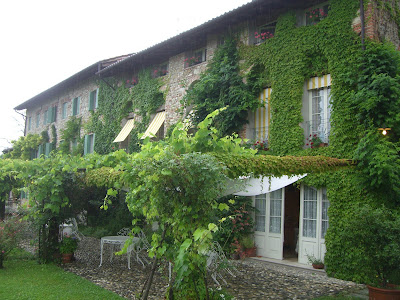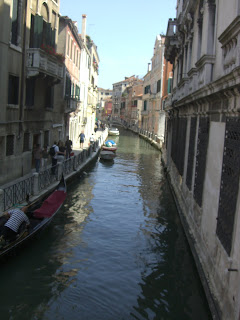Whenever I’ve accompanied students on various study abroad programs, I’ve encouraged them to keep a journal and have dutifully kept one myself. This year (2010) I’m taking a group of Georgia Tech students to Gorizia, Italy (on the Slovenian border in case you want to look at a map).
And since I’m requiring the students to blog, I decided to blog along with them.
Usually no one would want to read about my life. It’s a good life and satisfies me, but it lacks the high drama that makes for interesting reading. Actually I prefer it that way! But I get out of my routine when I travel, visit interesting places, meet new people, and do things that generally get me out of my comfort zone. And, yes, if I can’t figure out anything else to write about, I can always write about the food.
However, the blog will be about more than my life and food, for the subject for the course should be interesting too. The Georgia Tech program focuses on film, and the students take one class in film production (in which they work with students from the University of Udine to make a film) and one class in film history. After visiting the program in 2007 (on my way home from a Dracula conference in Romania), I decided that I really wanted to spend more time in Italy. The problem was that I’m basically a Victorian scholar. Italy and film are way outside my comfort zone.
Three years later I’m teaching a course on the Holocaust in Italian film, and identifying this subject was a journey in itself. A truly superstitious person might say that it was meant to be.
Growing up in a small town in Southwestern Ohio, I wasn’t aware of the Holocaust and certainly didn’t know any Holocaust survivors. Indeed, as an early Babyboomer, I had read The Diary of Anne Frank in junior high school and was only vaguely aware of the capture and trial of Eichmann. Indeed I was part of a generation that didn’t study the Holocaust in school and generally ran out of time in most history classes to touch on World War II.
Several things happened, though, to remind me of the Holocaust. When I graduated from Miami University, the commencement speaker was John Dolibois, who had worked at Miami and was then ambassador to Luxembourg. His message to the graduates was less the standard commencement fare about going out to conquer the world and more about facing unpleasant truths. You see, he served in Military Intelligence after graduating from Miami and had helped interrogate Nazi war criminals prior to the Nuremberg trials.
While in graduate school at the University of Buffalo, I had a summer research assistantship and was asked to compile a bibliography of works on the Holocaust, a field that was still relatively new. As someone who loves going to movies, I was also kept aware of the Holocaust by the sheer number of excellent films that were released in the 70s, 80s, and 90s. Like so many other Americans, I watched the television miniseries Holocaust, which dramatized the events.
Finally, several years ago, I heard Deborah Lipstadt give a talk at my church. Lipstadt, who is Professor of Modern Jewish History and Holocaust Studies at Emory University, is the author of a number of books, including History on Trial: My Day in Court with David Irving (2005) and Denying the Holocaust: The Growing Assault on Truth and Memory (1993). Indeed Profssor Lipstadt has made a career of debunking Holocaust deniers
Knowing that my students had probably studied the Holocaust in school, I nonetheless decided that the topic was important enough to warrant our study. I had seen so many thought-provoking movies that took the Holocaust as a topic, and I wanted to see if the class could make some sense of that terrible time.
Although I originally thought of looking at the Holocaust in Italian film, I eventually decided that I wanted to look at the way the Holocaust has been treated in both documentaries and fiction films. After screening literally hundreds of film, I also decided that students should see Triumph of the Will (not technically a Holocaust film but a film that demonstrates ordinary Germans being sucked under Hitler’s sway), Night and Fog (a French film), and Au revoir les enfants. More on these films later.
The class begins on May 17 and ends on June 24. You’re welcome to join my students and me as we travel to Italy and explore a difficult and painful topic. It will, I hope, be both a geographical and intellectual odyssey.

 Because the Riseria di San Sabbo is as much memorial as museum, it includes a kind of sculpture garden. The sculpture in the center here represents the smokestack.
Because the Riseria di San Sabbo is as much memorial as museum, it includes a kind of sculpture garden. The sculpture in the center here represents the smokestack.
 The floral tributes are more evident in the photograph on the left, which also preserves the tiny window from which prisoners could look out on the larger holding area.
The floral tributes are more evident in the photograph on the left, which also preserves the tiny window from which prisoners could look out on the larger holding area.

























